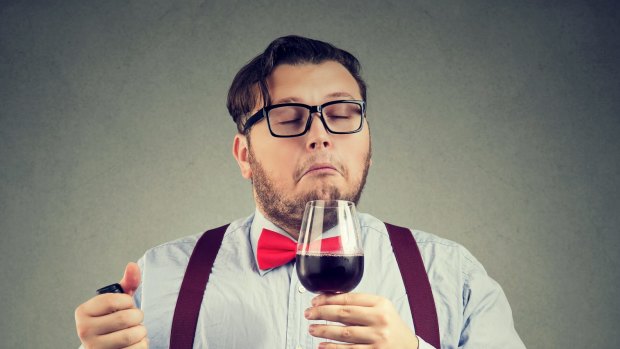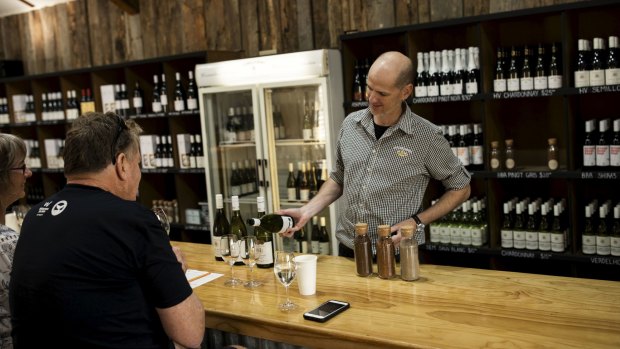Tips for visiting wineries: How to fake it and not look like an idiot
By Ben Groundwater

'Mmmmm ...smells like grapes.'Credit: SIphotography
Australians love a winery. There were 5.5 million visitors to Australian wineries last year. Those visits were worth $5.9 billion. This is a tourism juggernaut, and it's very likely that you too will be visiting an Australian winery very soon.
The only trouble is, you may not know the first thing about wine, and this can be an intimidating world to sink yourself into. All of that swirling and sniffing, all that black cherry and tanned leather and forest floor.
It's pretty easy to end up feeling silly. It's also easy to find yourself denied access to the premium wines that might be up for tasting because you clearly don't know what you're talking about. Fortunately though, help is at hand.

Nik Woodman at Tyrrell Wines in Pokolbin, Hunter Valley. Winemakers pour their heart and soul into their product, so don't be stingy with the compliments.Credit: Dominic Lorrimer
This is a case of "fake it till you make it". And here's how to do it.
Know the tasting process
There's a standard progression for tasting any wine, anywhere. Pick up the glass and hold it up to a light source, a window or a light bulb. Pretend to study its colour for a while. Next, stick your nose right into the glass and take a big whiff. Then, remove nose from glass, and give the glass a swirl. Stick your nose in it again, take another good nostril-full. Give the glass another little swirl, then take a sip of wine. Rinse and repeat, and insert knowledgeable comments (see below) in between any step.
Understand wine is like art
You don't need to know anything about wine except for one thing: what you like. All these tasting techniques that professionals use, all these words they employ to describe what they're experiencing – none of that really matters. It's essential, of course, if it's your job to taste and describe wine. But if you just like drinking for enjoyment, none of that other stuff means anything. So go in with confidence, not fear. As long as know what you like and what you don't like, that's all that matters. People will respect that.
Learn a few key words or phrases
I once found myself at a wine industry champagne-tasting event, where all of France's best champagne houses were pouring their finest drops for sommeliers and other professionals. I, clearly, was an imposter. However, a knowledgeable friend taught me a few things to ask about to cover my ignorance: "dosage", and "cepage". Dosage is the amount of sugar added to the wine; cepage is the type of grapes used. The winemakers lapped it up.
If you want to sound like you know what you're talking about at Australian wineries – and thus find yourself treated to tastings of the premium drops – you just need a few similar words and phrases. Talk about the nose instead of the smell. Mention something about the long finish. Ask about malolactic fermentation. Ask if they use a basket press. Easy.
Don't throw out any descriptors if you're not sure about them
Saying things like, "wow, lots of black cherry", or "smells like leather and wood, right?" is only going to make you look knowledgeable if you're right. If you're wrong, and you're just throwing words out there to see what sticks, you're going to look like you have no idea what you're talking about (because, you don't). So, rein in the chat. There's no need for that stuff – the person pouring the wine will probably tell you about it anyway. All you have to do is smile and nod and say "oh yeah, totally…".
Don't ever say you don't like a certain grape
It's fine to have preferences when it comes to wine. But to say, flat out, "I don't drink chardonnay", or, "I hate cab sav", is ridiculous. No grape is that much different to all of the others, and you can certainly stomach a sample to see if you like this winemaker's treatment of it. If you still don't enjoy it, no worries. Tip it into the spittoon. Move on. But as soon as anyone hears you shut down an entire varietal without even tasting anything, they won't take you seriously.
Be complimentary
Winemakers are usually intensely proud of their product – this is a year's worth of tinkering and toil in a bottle. So, feel free to gush with as much praise as you feel is necessary. Say it's beautiful, say you love it, say it's the best thing you've drunk in months. Your flattery will probably take you all the way to the premium tastings.
Be ready to purchase
People who are serious about wine (or even just properly interested) visit wineries with the intention to buy wine. Some will buy whole cases, others will only buy a bottle or two, but none are just tyre-kickers there to take advantage of free samples. So, don't be that person. It's pretty easy for the people doing the pouring to tell if their customers are genuinely interested in making a purchase, or genuinely interested in getting boozed on complimentary tastings. If you want to impress your friends and fake your way into the top-shelf samples, you also need to be prepared to open your wallet.
Relax
Remember: this is supposed to be fun. Whether you're super-serious about wine or you just like to have a drink every now and then, visiting a winery is meant to be enjoyable. So relax, and have a good time. Do the tasting ritual, ask the right questions, try to say the right things. But above all else, just have fun. Wine can attract its fair share of painful wannabes and difficult customers. You'll instantly put yourself in the good books if you're just there to enjoy.
What are your tips for successful winery visits? Do you worry about any of this stuff? Or just go with the flow? What's your favourite wine region or winery to visit?
Sign up for the Traveller Deals newsletter
Get exclusive travel deals delivered straight to your inbox. Sign up now.